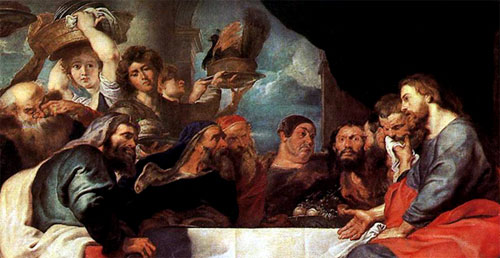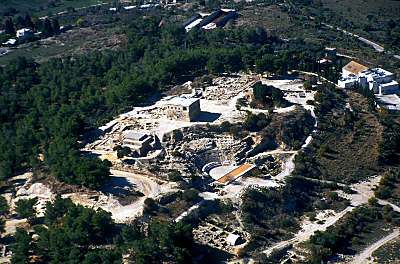
James Tabor
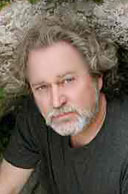 "James D. Tabor is chair of the department of religious studies at the University of North Carolina at Charlotte. He holds a Ph.D. in biblical studies from the University of Chicago and is an expert on the Dead Sea Scrolls and Christian origins. The author of several previous books, he is frequently consulted by the media on these topics and has appeared on numerous television and radio programs.
"James D. Tabor is chair of the department of religious studies at the University of North Carolina at Charlotte. He holds a Ph.D. in biblical studies from the University of Chicago and is an expert on the Dead Sea Scrolls and Christian origins. The author of several previous books, he is frequently consulted by the media on these topics and has appeared on numerous television and radio programs.
He has studied the earliest surviving documents of Christianity for more than thirty years and has participated in important archeological excavations in Israel. Drawing on this background, Tabor reconstructs for us the movement that sought the spiritual, social, and political redemption of the Jews, a movement led by one family. The Jesus Dynasty offers an alternative version of Christian origins ..." From:http://www.jesusdynasty.com/
Hear James speak about the book and his personal experiences:
http://www.jesusdynasty.com/Audio-Features-The-Jesus-Dynasty.html
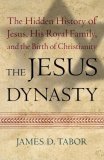
 The Jesus Dynasty:The Hidden History of Jesus, His Royal Family, and the Birth of Christianity (Hardcover) by James D. Tabor.
The Jesus Dynasty:The Hidden History of Jesus, His Royal Family, and the Birth of Christianity (Hardcover) by James D. Tabor.
If I wanted you to read any book this year and I only had one to choose, it would be this one! Jessika
Was Jesus conscious of his ministry? Was John the Baptist the teacher of Jesus or did they plan their ministry together? Was Mary a virgin or not? How many children did she have? Were the Herodians out to get Jesus and John from the beginning? How did the Temple authorities view Jesus? Were Jesus and John Essenes, or not? What is the Christian faith based upon, what Jesus taught according to the Gospels, or something else? The book, The Jesus Dynasty: The Hidden History of Jesus, His Royal Family, and the Birth of Christianity answers many of these questions. At present the book is being translated into over twenty languages, among them, French, German, Spanish, Portuguese, Russian, Chinese, Dutch, Japanese, and Italian, spreading through this year and into 2007and it is no wonder, why! It's a great read!
James D. Tabor has written, a more than timely revisionist history about the life of Jesus. So, what is new in this book, in light of all that has been written in other recent books? Tabor's view is new!
Focused in the cultural, political and theological climate of the later years of the Jewish State (the earliest years of Christianity), we find a Jesus who "espoused a set of biblical ethics based on the Hebrew Prophets." We meet Jesus and his family, as Jewish people jointly engaged in the fulfilling of a Jewish mission. Tabor presents us with a picture of Jesus as a Jewish man, living in a Jewish world. (click pic for larger)
Tabor, while thoughtfully considering "the search for the real Jesus" of numerous contemporary scholars both liberal and conservative, adds to, subtracts, and reframes our understanding of who Jesus was, how he lived, and what he taught. He makes good use of his own observations and erudite scholarship gained over many years, using academically approved historical methods. Tabor believes, and I agree, "An understanding of the Jesus dynasty ... offers new avenues of understanding between Jews, Christians and Muslims." He states,
"What Jews have rejected is not so much Jesus as the systems of Christian theology that equated Jesus with God, that nullified the Torah, and that displaced the Jewish people and their covenant.... A recovery of the perspectives of James and Jesus' other original followers who continued to hope and strive for messianic redemption, and who espoused a set of biblical ethics based on the Hebrew Prophets, even after Jesus' death, offers a point of unity and understanding hitherto neglected between Jews and Christians."
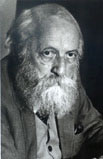 In his quest quest for a revision of the Biblical story according to sound historical premises, Tabor quotes the thought of the eminent Jewish scholar Martin Buber (left) who stated,
In his quest quest for a revision of the Biblical story according to sound historical premises, Tabor quotes the thought of the eminent Jewish scholar Martin Buber (left) who stated,
"I do not believe in Jesus but I believe with him. I firmly believe that the Jewish community in the course of its renaissance will recognize Jesus; not merely as a great figure in its religious history, but also in the context of a Messianic development extending over millennia, whose final goal is the Redemption of Israel and of the world."
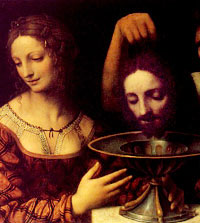 In The Jesus Dynasty, Tabor digs deeply into the societal fabric of the world of Jesus. Israel was ruled by the Herodians at the behest of the Romans, as we all know, but in Tabor's book we come face to face with the politics of the Herodians and the Temple authorities they installed from the Jewish people's point of view and in a Jewish context. During the course of the text, we come to understand how the politics and numerous beliefs of the sects of the time, very personally challenged the Jewish people intellectually, spiritually, and morally. Neither of the ruling parties of the institutions of that day, retained authentic hereditary lineages in the eyes of the Jewish people. Tabor reminds us that many Messiahs had come and gone by the first century. Jesus and John the Baptist were not the first, nor were they the last in the anticipated wait for the Messiahs, but the text suggests, they were the only ones to have had such a large following and they appeared at a time when the Messiahs were expected to appear.
In The Jesus Dynasty, Tabor digs deeply into the societal fabric of the world of Jesus. Israel was ruled by the Herodians at the behest of the Romans, as we all know, but in Tabor's book we come face to face with the politics of the Herodians and the Temple authorities they installed from the Jewish people's point of view and in a Jewish context. During the course of the text, we come to understand how the politics and numerous beliefs of the sects of the time, very personally challenged the Jewish people intellectually, spiritually, and morally. Neither of the ruling parties of the institutions of that day, retained authentic hereditary lineages in the eyes of the Jewish people. Tabor reminds us that many Messiahs had come and gone by the first century. Jesus and John the Baptist were not the first, nor were they the last in the anticipated wait for the Messiahs, but the text suggests, they were the only ones to have had such a large following and they appeared at a time when the Messiahs were expected to appear.
Yes, Messiahs plural, two were expected the author informs us. As we delve into the world of Jesus, we begin by recognizing that the Essenes and some other of the Jewish sects, though not all, taught that there would be two Messiahs who would appear together: one would be a Davidic King, the other would be a Priest of the lines of Aaron. Another scholar, L. Michael White: Professor of Classics and Director of the Religious Studies Program University of Texas at Austin writes,
"At Qumran [pictured below] below, ... among the Dead Sea Scrolls, we hear not of just one Messiah, but at least two Messiahs. Some of their writings talk about a Messiah of David that is a kind of kingly figure who will come to lead the war. But there's also a Messiah of Aaron, a priestly figure, who will come to restore the Temple at Jerusalem to its proper purity and worship of God. In addition to these two major Messianic figures, we also hear of a prophet figure."
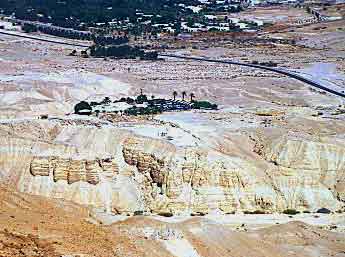
Tabor's book proposes that Jesus and John the Baptist were members of a Jewish sect, that was waiting for two Messiahs. He asserts that they may have even been Essenes, members of a branch of the Essenes, or a like group (there were many he points out) with a similar outlook. He asserts that Jesus and John the Baptist were intentionally fulfilling the roles of the two Messiahs and that the family of Jesus had a hereditary right to do so, that a very great number of the population, especially in Galilee, where Jesus spent most of his time preaching, supported Jesus and John in those roles, and that Jesus and John's movement were a very real threat to the Herodians and their rule.
In support of his assertions, the author raises some not so obvious questions and seeks to answer them. For example: Why did Jesus designate, twelve disciples and set up a council of seventy, similar to the Sanhedrin? Why did he send the seventy out ahead of himself to the places he was about to visit? Just how many people followed Jesus? What did Jesus mean when he said, "Whoever listens to you listens to me. Whoever rejects you rejects me. And whoever rejects me rejects the one who sent me."? Did Jesus perceive of himself as the only Son of God? Did Jesus know he would be crucified? What was his reaction when John the Baptist was killed? Was Jesus a Disciple of John or were they working together? Were Jesus and John rebels? Was Mary a virgin? How many other children did Mary have and what role did these children play? Who was the beloved disciple? Who was "James the Just"?
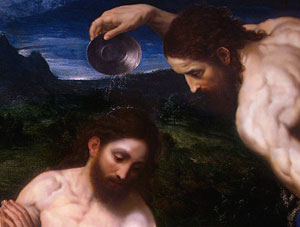
We also look at the influences of Paul, a bit. What was Christianity really like in the early days, before Paul? Did Jesus start a new religion and did he mean to, or was he simply a prophet speaking to his people in his own time? How did the Eucharistic practice originate? Did Jesus initiate the Eucharistic practice as told to us in Mark 14:22-24: "And as they did eat, Jesus took bread, and blessed, and brake it, and gave to them, and said, Take, eat: this is my body. And he took the cup, and when he had given thanks, he gave it to them: and they all drank of it. And he said unto them, This is my blood of the new testament, which is shed for many...."or did Paul, who was essentially a Greek Jew emulate the mystery schools which practiced similar rituals in honor of Greek gods?
 Many of these questions have been addressed by other authors, however no author to date, that I have read, has provided such a comprehensive, well thought out, and historically documented synthesis of known facts, as may be found in this book. Grounded in history, archeology, and primary sources, assertions are logical and rational. As we follow Tabor throughout the text, he backs up conclusions, citing key statements in the New and Old Testaments, passages of The Nag Hammadi texts, The Dead Sea Scrolls, Josephus, and other numerous ancient writers.
Many of these questions have been addressed by other authors, however no author to date, that I have read, has provided such a comprehensive, well thought out, and historically documented synthesis of known facts, as may be found in this book. Grounded in history, archeology, and primary sources, assertions are logical and rational. As we follow Tabor throughout the text, he backs up conclusions, citing key statements in the New and Old Testaments, passages of The Nag Hammadi texts, The Dead Sea Scrolls, Josephus, and other numerous ancient writers.
Tabor supplements his analysis and reconstruction, with fascinating little tid-bits, noting a number of mistranslations in Biblical texts, both canonical and non-canonical. He demonstrates how inaccurate understandings of the texts have effected how we have viewed, not only primary sources, which he quotes extensively, but also the stories of the New Testament. For example the word Nazarite, meaning "a separated one" is often confused with Nazarene, meaning, "the town of the 'branch' " referring to the royal line of King David. "The Jesus movement was early on referred to as the 'Nazarenes', which roughly translates as 'the Messianists' or the people of the 'Branch' ". Mahlon H. Smith writes, Nazareth, the home of Jesus,
"according to the Gospels (Mark 1:9; Matt 2:23, 21:11; Luke 1:26, 2:4; John 1:45-46), situated about 20 miles east of the Mediterranean & 15 miles west of Lake Gennesareth, less than 5 miles west of Mt. Tabor, the highest point in southern Galilee. Built on the southeastern slope of a ridge at 1300 feet above sea level, with a commanding view of the broad valley of Jezre'el to the south, Nazareth probably gained its Hebrew name as a lookout or "watchtower" for the defense of Galilee [from natzar: "to watch" or "to guard"].... Tombs & agricultural evidence (silos, cisterns, olive & wine presses) provide concrete evidence that the site was inhabited from the early days of Israelite occupation of the land [12th c. BCE]. But the ancient settlement was never large, since it had only one spring. The 1st c. village, whose population was less than 500, was overshadowed by the fortified town of Japha just one mile south---described by Josephus as the 'largest village in Galilee' (Vita 230) --- and the city of Sepphoris, just 3.5 miles to the northwest."
"Nazareth itself was not a site of historic or major strategic importance &, thus, did not merit notice in any ancient text apart from the gospel references to it as the place of Jesus' origin. The earliest non-Christian reference is an inscription discovered in the synagogue of Caesarea Maritima that names Nazareth as one of the places in Galilee where the priestly families of Judea migrated after the Hadrianic war [135 CE]."
See "a view from Megiddo across valley of Jezreel toward Nazareth (right horizon) 15 miles northwest."
Tabor reminds us that our view of the period in which Jesus lived, was created by late on the scene (italics mine) authors with a vested interest in sustaining and perpetuating their own right (italics mine) view of Jesus and his life. He shows us how we have been both intentionally and unintentionally mislead, because the writers themselves were either receiving second hand information, or were perpetuating a misunderstanding of their own.
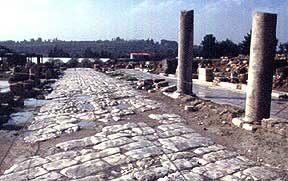 Through Tabors eyes, we are able to distinguish a more realistic picture of Jesus. While this view is counter to that which was perceived of and told about through Paul, (our earliest biblical writer) in the New Testament, the view is nonetheless difficult to dismiss. Tabor takes us on a walk through Jesus' life, beginning with Mary's life and the circumstances of Jesus' birth. On this walk, we grow up with Jesus, and later, we follow him in his ministry. In doing so we are able to clearly visualize both Galilee and Judea and the political climate of the day from a Jewish perspective. (Right: A street in Sepphoris: note sidewalk to the right side of the pillars. Jesus probably walked there.)
Through Tabors eyes, we are able to distinguish a more realistic picture of Jesus. While this view is counter to that which was perceived of and told about through Paul, (our earliest biblical writer) in the New Testament, the view is nonetheless difficult to dismiss. Tabor takes us on a walk through Jesus' life, beginning with Mary's life and the circumstances of Jesus' birth. On this walk, we grow up with Jesus, and later, we follow him in his ministry. In doing so we are able to clearly visualize both Galilee and Judea and the political climate of the day from a Jewish perspective. (Right: A street in Sepphoris: note sidewalk to the right side of the pillars. Jesus probably walked there.)
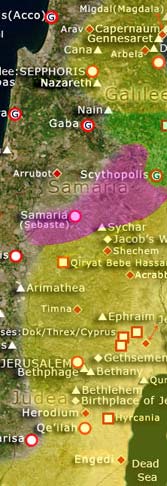 We are able to personally relate to what Jesus may have saw, felt, and thought as a Jewish man living in a Jewish state in a Greco-Roman world, under an illegally installed (from the point of view of the Jewish people) Herodian rule. (Click on the map at left for a larger map of Israel in Jesus' time period: not noted is that besides Hebrew settlements, all cities contain Jewish populations.)
We are able to personally relate to what Jesus may have saw, felt, and thought as a Jewish man living in a Jewish state in a Greco-Roman world, under an illegally installed (from the point of view of the Jewish people) Herodian rule. (Click on the map at left for a larger map of Israel in Jesus' time period: not noted is that besides Hebrew settlements, all cities contain Jewish populations.)
As for Mary, Tabor asserts that she had at least six children, four boys and two girls. These would have been, not only the brothers and sisters of Jesus, but also disciples, engaged and equally supportive of the larger mission of restoring persons with authentic lineage to both the government and the Temple. Mary becomes a human being in our eyes; as such, she expands in dimension for we are able to perceive of her mission as equally important to the broader mission. She becomes not just the Mother of Jesus, but also the matriarchal head of a family, who have a divine mission. Mary is seen in her role as an heir to the Davidic lines. We see Mary through the eyes of a tribal people. She is royalty.
In conjunction, to the story of Mary, Tabor leads us through the line of succession that would have occurred at the death of Jesus according to the tradition of the times. The evidence as presented suggests that the families of Jesus and John the Baptist were viewed by many of the population as rightful heirs to both the Davidic Kingship and the Aaronic Priesthood. The "Davidic line, (also House of David or Davidic Dynasty, sometimes referred to as Royal House of Israel), known in Hebrew as Malkhut Beit David ("Monarchy of the House of David") refers to the tracing of royal lineage by kings and major leaders in Jewish history to the Biblical King David in Judaism. This makes sense in light of the fact, that people of the era put a lot of stock in lineage, especially biblical peoples, who most if not all, kept careful track of ancestral lines.
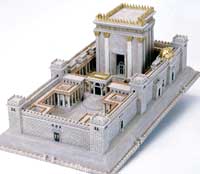 It was only with the destruction of the Temple in 70 C.E. that such records were lost. Jewish people who are members of the Aaronic priesthood, are called kohen, and even today, know who is of the hereditary priesthood. The evidence suggests, in light of the fact that John the Baptist performed priestly ritual immersion, that John the Baptist was a kohen and a member of the tribe of Levi.
It was only with the destruction of the Temple in 70 C.E. that such records were lost. Jewish people who are members of the Aaronic priesthood, are called kohen, and even today, know who is of the hereditary priesthood. The evidence suggests, in light of the fact that John the Baptist performed priestly ritual immersion, that John the Baptist was a kohen and a member of the tribe of Levi.
John the Baptist was according to Luke and Luke 3: 1-20, was the son of Zacharias, a priest and of Elisabeth, also of priestly descent. Luke 1:5 states, "There was in the days of Herod, the king of Judaea, a certain priest named Zacharias, of the course of Abia: and his wife was of the daughters of Aaron, and her name was Elisabeth." The angel Gabriel announced John's birth to Zacharias while he, as a priest stood at the altar offering incense, and told him that this child would be a Nazarite for life " filled with the Holy Spirit from his mother's womb, he would be called upon to convert the children of Israel to God, and with the power of Elijah would turn the hearts of the fathers to the children while preparing the people for the Lord."
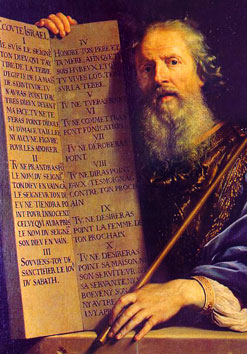 According to the Old Testament, the status of kohen was first conferred on Aaron, the brother of Moses, and his direct male descendants, by God (Exodus 28:1, 2–4) as an "everlasting office". As we can see from the following we should not underestimate the importance to the Jewish people of keeping track of the Aaronic Priesthood.
According to the Old Testament, the status of kohen was first conferred on Aaron, the brother of Moses, and his direct male descendants, by God (Exodus 28:1, 2–4) as an "everlasting office". As we can see from the following we should not underestimate the importance to the Jewish people of keeping track of the Aaronic Priesthood.
"The Levites were the only one of the Israelite tribes who received cities but no tribal land when Joshua led the Israelites into the land of Canaan. The Tribe of Levi served particular religious duties for the Israelites and had political responsibilities as well. In return, the landed tribes were expected to give tithe to the Levites... In traditional Judaism, tribal status is determined by patrilineal descent, so a child whose biological father is a Levite is a Levite.... Because Jewish status is traditionally determined by matrilineal descent, conferring levitical status on children requires both biological parents to be Jews and the biological father to be a Levite.
Most of the Temple service (i.e. the korbanot) could be conducted only by kohanim. Non-kohen Levites (i.e. all those who descend from Levi, the son of Jacob, but not from Aaron) provide a variety of other Temple roles, most notably providing music and songs (Psalms) to accompany the Temple ceremonies but also a variety of other duties including standing guard over the Temple and Temple Mount, construction, maintenance, and assisting the kohanim by washing their hands and feet before services. [What ritual was Jesus really performing when he washed the hands and feet of the Disciples, we might ask?]
During the era of the Tabernacle, the Levites were employed in caring for and transporting the Tabernacle between travel destinations. During the 40 years in which the Jews wandered in the wilderness and until the Holy Temple was built in Jerusalem, the kohanim performed their service in the portable Tabernacle (Numbers 1:47–54; 3:5–13,44–51; 8:5–26). Their duties involved offering the daily and Jewish holiday sacrifices, collectively known as the korbanot in Hebrew, and blessing the people in a ceremony known as Nesiat Kapayim ("raising of the hands"), the ceremony of the Priestly Blessing.
When the First and Second Temples were built, the kohanim assumed these same roles in these permanent structures, located on the TempleMount in Jerusalem, Israel (right). They were divided into 24 work groups of seven to nine priests each. Those who served ... [rotated in service] ... every Shabbat, but on the biblical festivals all twenty-four were present in the Temple."
"Even in death, many kohanim choose to have this symbol (right), the special positioning of their fingers and hands during the Priestly Blessing, placed as a crest or symbol on their gravestones to indicate their status."
As to Jesus' resurrection, we are informed (a known fact amongst historians, but not amongst the general population) that the resurrection accounts in the NT were added later, centuries later. So what happened to the body of Jesus? The author presents several possibilities. (Personally, I think Herod took his body to prevent martyr worship at his grave site.) We may note here that John the Baptist's body also disappeared, although some assert his body has been found a grave at Qumran. It was customary in the ancient world when one wiped out legitimate heirs to also wipe out any trace of the family.
"The early Israelites apparently believed that the graves of family, or tribe, united into one. This unified collectivity became known as Sheol. Although not well defined in the Tanakh, Sheol was a subterranean underworld where the souls of the dead went after the body died. The Babylonians had a similar underworld called Aralu, and the Greeks had one known as Hades. For biblical references to Sheol see Genesis 42:38, Isaiah 14:11, Psalm 141:7, Daniel 12:2, Proverbs 7:27 and Job 10:21,22, and 17:16, among others. Other Biblical names for Sheol were: Abbadon (ruin), found in Psalm 88:11, Job 28:22 and Proverbs 15:11; Bor (the pit), found in Isaiah 14:15, 24:22, Ezekiel 26:20; and Shakhat (corruption), found in Isaiah 38:17, Ezekiel 28:8....
From the time of its development from within Judaism during the second-Temple period to the incipient decades of Christianity, the meaning of the word acquired sharper edges and mutations, to include differentiating the common quality of the premortem body from the new glorious quality of the postmortem body (cf. 1 Cor. 15:35-54 and the Gospel accounts of Easter). It held to a permanent unification of physical body and soul.... Resurrection was... [also]... used figuratively as a metaphor both for the national restoration of Israel (Ezek. 37) in Judaism, and for the regenerate life (the Apostle Paul) in Christianity."
As for Mary and her Royal lineage, the New Testament states:
Luke 1:26-33 26 And in the sixth month the angel Gabriel was sent from God unto a city of Galilee, named Nazareth, 27 To a virgin espoused to a man whose name was Joseph, of the house of David; and the virgin's name was Mary. 28 And the angel came in unto her, and said, Hail, thou that art highly favoured, the Lord is with thee: blessed art thou among women. 29 And when she saw him, she was troubled at his saying, and cast in her mind what manner of salutation this should be. 30 And the angel said unto her, Fear not, Mary: for thou hast found favour with God. 31 And, behold, thou shalt conceive in thy womb, and bring forth a son, and shalt call his name JESUS. 32 He shall be great, and shall be called the Son of the Highest: and the Lord God shall give unto him the throne of his father David: 33 And he shall reign over the house of Jacob for ever; and of his kingdom there shall be no end.
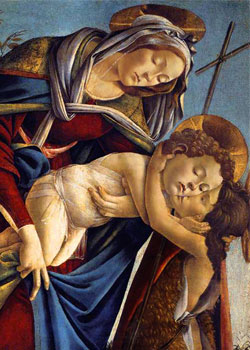 Joseph, of the lines of David, and as a member of the tribe of David, would have been aware of the Royal mission of the family. The Gospel of Luke does not explicitly name either of Mary's parents, but some argue that the genealogy in Luke 3 is that of Mary rather than Joseph, thereby naming her father as Eli. Catholic and Orthodox theologians who hold to this say "Eli" may be short for "Eliakim," which is similar to "Joachim." (click pic for larger)
Joseph, of the lines of David, and as a member of the tribe of David, would have been aware of the Royal mission of the family. The Gospel of Luke does not explicitly name either of Mary's parents, but some argue that the genealogy in Luke 3 is that of Mary rather than Joseph, thereby naming her father as Eli. Catholic and Orthodox theologians who hold to this say "Eli" may be short for "Eliakim," which is similar to "Joachim." (click pic for larger)
The Gospel of James, also sometimes known as the Infancy Gospel of James or the Protevangelium of James, is an apocryphal Gospel probably written about AD 150 in other words early on before the tribal history was completely wiped out by time. The Infancy Narrative of James is also known as the Protevangelium of James may be the earliest surviving document asserting that Mary was of the House of David. Chapter 10: (2) And the high priest said, "Call the pure virgins from the tribe of David to me." (3) And the servants went out and sought and found seven virgins. (4) And the high priest remembered that the child Mary was from the tribe of David and was pure before God. (5) So the servants went out and got her.
Tabor, leads us to possibility that it is altogether possible that Mary may have been married earlier, noting the many arguments surrounding the interpretation of the term virgin; one of which is that, the term virgin is actually a mistranslation of the word almah which some scholars argue means young girl. Still others, assert almah means one who has not yet given birth. A Wikipedia article provides a lengthy discussion of the term and a chart noting various biblical passages that use the term and how it may be translated.
"From the earliest days of Christianity, Jewish critics have argued that Christians were mistaken in their reading of almah in Isaiah 7:14.[16] In particular, the author of Matthew 1:23, believed that Jesus was born of a virgin, and then quoted Isaiah: "Behold, a virgin shall be with child, and shall bring forth a son" as a proof-text of Jesus' divine origins. Jewish scholars declare that Matthew is in error: the word almah means young woman (just as the male equivalent elem means young man). It does not mean virgin. While young men and young women tend to be virgins, the word almah does not refer to sexual purity, but only to age. Bolstering this point, a different Hebrew word, bethulah... , is the word most commonly used for virgin (even in modern Hebrew). Since bethulah is not used in Isaiah 7:14, the prophet could not have meant virgin."
Personally, while the Protevangelium of James may be of a legendary nature, nevertheless, in light of the facts above that the Jewish people kept track of tribal associations and in light of other facts, such as the clear fact that the Herods did not have such lines, and would have been threatened by anyone who did, it seems to me that we may accept that Mary was of the House of David. In any event, the general conclusion may be asserted that Joseph took Mary as his wife to insure that the Royal Davidic Line and heritage of the child she was carrying would be preserved.
Of course, we will never really know the whole truth about Mary's situation, but whatever the circumstances of Jesus' paternity, our author suggests, Herod and the powers that were, and who were in league with Rome, had full knowledge of Jesus' Davidic lineage and also of the lines of John the Baptist's Aaronic lineage. Given this information, and the fact that Israel as a whole at the time was against Herodian rule because they were seen as illegitimate heirs to such rule, we can see that the Herods may have been actually watching "the family of Jesus" including that of John the Baptist, you might say, and may have been out to get them from the very start; after all, it was the age when Messiahs having legitimate lines were expected to appear.
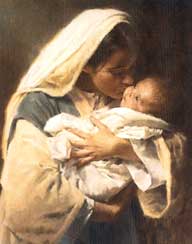 As the text moves along, and we get a picture of Mary as a real mother with six children, who had inherited the Davidic lines. We also perceive James, the brother of Jesus, as the legal successor, destined to take over Jesus' ministry after Jesus died. According to the New Testament, James was killed under Herodian rule as was Jesus. The text distinctly states that that James was killed by Herod; James was killed at the behest of the political establishment. Acts 12:1-2: 1Now about that time Herod the king stretched forth his hands to vex certain of the church. 2 And he killed James the brother of John with the sword. Given the information, we are able to draw the conclusion that the death of James was not an attempt to get rid of James by the Jewish population; rather, we are able to see it was really another attempt by Herod to get rid of still another legitimate claimant to his throne.
As the text moves along, and we get a picture of Mary as a real mother with six children, who had inherited the Davidic lines. We also perceive James, the brother of Jesus, as the legal successor, destined to take over Jesus' ministry after Jesus died. According to the New Testament, James was killed under Herodian rule as was Jesus. The text distinctly states that that James was killed by Herod; James was killed at the behest of the political establishment. Acts 12:1-2: 1Now about that time Herod the king stretched forth his hands to vex certain of the church. 2 And he killed James the brother of John with the sword. Given the information, we are able to draw the conclusion that the death of James was not an attempt to get rid of James by the Jewish population; rather, we are able to see it was really another attempt by Herod to get rid of still another legitimate claimant to his throne.
As we can see from the above ancestral lines and one's rightful role in society were very important. When the author addresses the question of Mary and Jesus' paternity, he points out that great heroes of the Bible were often of questionable birth and suggests that literary license was taken in the writing of Jesus' birth story for purposes of dramatic flair. Tamar, Rahah, Ruth and Bathsheba, Tabor points out, were all important women of the Bible who gave birth to important figures in the Bible and all had scandalous reputations. Biblia.com states. "Matthew takes great care ... in his genealogical record" to include "the names of... women through whom the Messiah came ... whom would have been ‘disqualified’ if God’s calling depended upon the righteousness of the Law."
"1- Tamar, Mat.1:3:
Tamar is a Canaanite woman wife of Judah’s eldest son, Er (Ge.38:1-7).
Gen 38:11-30 informs us that Judah’s daughter-in-law, deprived of a promised husband (the last of Judah’s sons), impersonated a harlot. She enticed Judah to lie with her and from that illicit union came two sons - Perez and Zerah. And from Perez sprung Boaz, David and ultimately the Christ.
2- Rahab, Mat.1:5:
Rahab was known as ‘the harlot’ (Joshua 2:1).
Because Rahab had given friendly welcome to the spies, she’d exercised faith in the spies’ God (Heb 11:31). She believed that Jehovah was about to destroy Jericho and give Israel Canaan, so she petitioned the spies to spare her (Joshua 2:9-13).
Having entered into a covenant agreement with her (Joshua 2:14,17-20), she tied a red cord in the window, demonstrating her faith (belief in action) and was saved by Jehovah who didn’t let her habitation in the wall be destroyed (Joshua 6:25)... and she became the mother (ancestor) of Christ.
3- Ruth, Mat.1:5:
Ruth was a Moabitess, a gentile, a pagan (Ruth 1:4)
From her marriage union with Boaz, David came and the greater Son of David, Jesus. David, strictly speaking, was the third generation from Ruth,
4- Bathsheba, Mat.1:6:
She had adultery with King David (2S.11:4).
- Solomon, her son with David, was the ancestor of Joseph (Mat.1:7)... the "legal father" of Jesus.
- Nathan, the other son with David, was the ancestor of Virgin Mary (Lk.3:31)... the "real mother" of Jesus, thus avoiding the Jeconiah curse."
Tabor also addresses the rumor that Mary was impregnated, possibly by a Roman soldier named Pantera, and goes to lengths to make the mention interesting reading. The rumored soldier, may have been, he asserts, of a Jewish family, sent off unexpectedly to serve in a foreign country at an inopportune time. Tabor even takes us on a trip to Germany to the grave site of a soldier, drawing for us, the possible connections between he and a family of the same name, who lived in Palestine in the relevant time period. While no final conclusion is presented regarding Pantera, we are able to discern that Mary may have been impregnated by this soldier or someone else who disappeared from the scene for one or another reason. Scott Bidstrup states,
"The most prominent of the many movements to 'reJudaify' Judaism was the Essene Movement. Founded in the second century B.C.E., the Essenes were either founded by or greatly influenced by a "Teacher of Righteousness," to which the Dead Sea Scrolls make constant reference without ever naming. One individual who fits the scanty evidence is a Yeishu ha Notzri, Jesus or Jesua, or Yeshua or Joshua ben Pantera or Pentera or Pandera or Pandira, who apparently had some influence with this movement, but may have been much more than that; we simply don't know. Indeed, there are even several first-century Christian references to this supposed miracle worker.
If he was the Teacher of Righteousness referred to by the Dead Sea Scrolls, as some have suggested, his impact on the movement towards Jewish reform was considerable. And if he was the Teacher of Righteousness, it would answer a lot of interesting questions, such as the scattered first century Christian and Talmudic references to a miracle worker named Yeishu ha Notzri, known to first-century Christians as Jesus or Jesua ben Pantera. Among them are a quote from Origen, saying that his arch-rival Celsus had heard from a Jew in Jerusalem that "Jesus Ben Pantera" was born of Mary as the result of a rape by a Roman soldier named Pantera, and had borne the baby in secret (most scholars now regard this claim to be a first-century legend resulting from misinterpretation of the facts)."
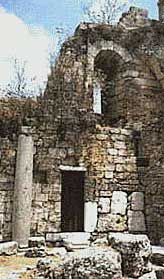 As to the parents of Mary and her lineage we have only legendary accounts. Legend tells us that Jesus' grandparents, Mary's parents, Joachim and Anna , are traditionally considered to have come from Sepphoris (right: tradition has it this was their home). As we follow along, we begin to understand that Sepphoris was a very important city in the life of Jesus and Mary. Sepphoris, was the capital of Galilee for a time, and as such was not only a symbol of Roman dominance, but also a symbol of the dominance of "Herodian kingship", a family who had absolutely no hereditary rights to rule over the people.
As to the parents of Mary and her lineage we have only legendary accounts. Legend tells us that Jesus' grandparents, Mary's parents, Joachim and Anna , are traditionally considered to have come from Sepphoris (right: tradition has it this was their home). As we follow along, we begin to understand that Sepphoris was a very important city in the life of Jesus and Mary. Sepphoris, was the capital of Galilee for a time, and as such was not only a symbol of Roman dominance, but also a symbol of the dominance of "Herodian kingship", a family who had absolutely no hereditary rights to rule over the people.
The importance of the city of Sepphoris to biblical era lives, has only relatively come to light within the last 30 years or so. Sepphoris was first excavated by L. Waterman of Michigan University in 1931. In 1983, J. F. Strange of the University of South Florida began a survey of buildings, cisterns, and burial systems. A joint team from Duke University, North Carolina, and The Hebrew University began work in 1985.(Picture of Sepphoris below is from http://www.bibleplaces.com/sepphoris.htm)
Now, when Mary was about 14 years old, Sepphoris (above), was razed to the ground. In conjunction, 2000 Jews who had rebelled against Herod the Great's rule, were crucified on the roads leading to Sepphoris. Many of the populace were taken into slavery and we may assume many women were raped (a common practice amongst the Romans). Sepphoris was also home to of one of the oldest Jewish communities. The city was set on a hill and visible from Nazareth only four miles away (the author provides a photo taken from the standpoint of Sepphoris). What did Jesus and his family see every morning upon awakening ? — Sepphoris, the seat of illegal Herodian rule.
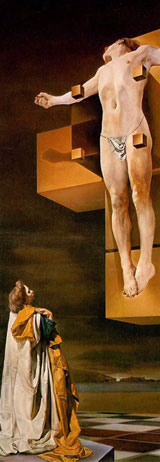 Rebellions and crucifixions were standard fare, in those days, however these particular crucifixions were a sign to the people of the times in that the Davidic household was affected at a time when the Messiahs were expected to appear. The Hebrew word Mashiach (or Moshiach) means anointed one, and refers to a human being who will usher in a messianic era of peace and prosperity for both the living and the deceased in a time when all seems lost. In the eyes of the people the destruction of Sepphoris was another event, perceived of as a sign of the end times when the Messiahs would appear.
Rebellions and crucifixions were standard fare, in those days, however these particular crucifixions were a sign to the people of the times in that the Davidic household was affected at a time when the Messiahs were expected to appear. The Hebrew word Mashiach (or Moshiach) means anointed one, and refers to a human being who will usher in a messianic era of peace and prosperity for both the living and the deceased in a time when all seems lost. In the eyes of the people the destruction of Sepphoris was another event, perceived of as a sign of the end times when the Messiahs would appear.
Mashiach is the Hebrew word for Messiah. The word Messiah in English means a saviour or a "hoped-for deliverer". The word Mashiach in Hebrew actually means "anointed". In Biblical Hebrew the title Mashiach was bestowed on somebody who had attained a position of nobility and greatness. For example, the High Priest is referred to as the Kohen Hamashiach.
"The concept of the messiah varies in traditional and contemporary Judaism. The view of the messiah in talmudic literature is that there are two messiahs, Moshiach ben Yossef (Messiah son of Joseph) and Moshiach ben David (Messiah son of David). [1] The Hebrew ben can mean either son or descendant. In this sense it can also mean "in the manner of", i.e., there will be a "suffering servant" messiah in the manner of Joseph son of Israel/Jacob and a different messiah in the manner of King David."
Due to that fact, these crucifixions were a significant event in Galilee, they affected all of the people of Galilee, Greater Israel, meaning Judea and Samaria, and the Jews of the Diaspora. It was time when Isaiah's (Chapter 61) and Hosea's (Hosea 6:1-2) prophecies were expected to be fulfilled. Next to Jerusalem, Sepphoris was a key city in the history of the Jewish state. Its being taken over as a Herodian capital was not to the liking of the Jewish population.
" ... Sepphoris is at least as old as the 7th century BCE, when it is fortified by the Assyrians, subsequently serving as an administrative center in the region under Babylonian, Hellenistic and Persian rule. Throughout this time period, the city was known as Sepphoris. In 104 BCE, Hasmonean tribes that had taken over much of the region laid claim to the city under the leadership of either Alexander Jannaeus or Aristobulus I. [4] The city was called Tzippori and may have derived from the Hebrew word for 'bird,' tsippor, perhaps because of the birds-eye-view the hilltop provides. The Hasmonean Kingdom was divided into five districts by the Roman pro-consul Gabinius and Sepphoris came under the direct rule of the Romans in the year 37 BCE, when Herod the Great captured the city from Mattathaias Antigonus reportedly at the height of a snowstorm. [5] After Herod's death in 4 BCE, the city's largely Jewish inhabitants organized riots against Roman rule. The Roman army moved in, under the command the Roman Governor in Syria, Varus. The Roman army completely destroyed the city and sold many of its inhabitants into slavery. [6] Herod's son, Herod Antipas was made Tetrarch, or governor in 1 CE, and he proclaimed the city's new name, Autocratis, or the 'Ornament of the Galilee.' [7]" (for more see ... http://en.wikipedia.org/wiki/Sepphoris )
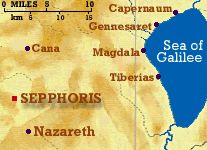 So, Sepphoris (left), only four miles from Nazareth, played a pivotal role in the history of Israel and it appears in the lives of Jesus and his family. The city was rebuilt by Herod Antipas, son of Herod the Great, as a Greco-Roman city and made the capital of Galilee during the time that Jesus was growing up. Sepphoris had a significant Jewish population and we may expect that Jesus worked there and may have had family there as noted above. Jesus was not a carpenter (a mistranslation, one of many Tabor notes throughout the book), he was a stone mason. Considering the size and importance of Sepphoris as a center of Jewish learning, Jesus, called a Rabbi, and as an inheritor of the Davidic lines, must certainly would have studied there.
So, Sepphoris (left), only four miles from Nazareth, played a pivotal role in the history of Israel and it appears in the lives of Jesus and his family. The city was rebuilt by Herod Antipas, son of Herod the Great, as a Greco-Roman city and made the capital of Galilee during the time that Jesus was growing up. Sepphoris had a significant Jewish population and we may expect that Jesus worked there and may have had family there as noted above. Jesus was not a carpenter (a mistranslation, one of many Tabor notes throughout the book), he was a stone mason. Considering the size and importance of Sepphoris as a center of Jewish learning, Jesus, called a Rabbi, and as an inheritor of the Davidic lines, must certainly would have studied there.
Although the Tabor does not discuss the teachers of the time, some scholars suggest that Jesus was a student of Hillel. As Sepphoris was a Jewish center of learning Hillel would have visited and taught there. The way in which a number of Jesus' teachings are stated suggests that he was a student of Hillel or at least subscribed to or agreed with his teachings.
"Hillel was a famous Jewish religious leader who lived in Jerusalem during the time of King Herod; he is one of the most important figures in Jewish history, associated with the Mishnah and the Talmud. He was the founder of the Beit Hillel ("House of Hillel") school, a school for Tannaïm (Sages of the Mishnah); and the founder of a dynasty of Sages who stood at the head of the Jews living in the land of Israel until about the fifth century of the Common Era.... His two best-known statements are probably:
If I am not for myself, then who will be for me? And when I am only for myself, what am I? And if not now, when? (Pirkei Avot 1:14)
That which is hateful to you, do not do to your neighbor. That is the whole Torah; the rest (is commentary, the explanation); go and study it. (Babylonian Talmud, tractate Shabbat 31a)"
(For more see: http://en.wikipedia.org/wiki/Hillel_the_Elder)
 The above teachings sound very much like Jesus. Even, if Hillel was not a teacher of Jesus, we may assume that given the status of Jesus as a Rabbi, that he at least studied with Hillel. Hillel no doubt visited Sepphoris on occasion and we know certainly that Jesus visited Jerusalem. While the date of Sepphoris' exact establishment is a point of some dispute, its history as a center of learning and as a center of Jewish learning specifically, is undebatable.
The above teachings sound very much like Jesus. Even, if Hillel was not a teacher of Jesus, we may assume that given the status of Jesus as a Rabbi, that he at least studied with Hillel. Hillel no doubt visited Sepphoris on occasion and we know certainly that Jesus visited Jerusalem. While the date of Sepphoris' exact establishment is a point of some dispute, its history as a center of learning and as a center of Jewish learning specifically, is undebatable.
Just looking at Sepphoris as an example, and at what we know about the Hellenization of Israel, contrary to poplar notions, we can see that Jesus was definitely exposed to Greco-Roman civilization and definitely spoke Greek. In a Greek speaking Israel, he would have had to speak Greek. While Arabic is touted as the language of the day for the common people, the educated classes all spoke Greek. There are scholarly arguments concerning what languages Jesus spoke, however these seem ridiculous to me. The common language of the Jewish Diaspora was Greek and the Hebrew Bible at the time was in Greek. Jesus would have conversed with Greeks in Greek, as well as with the common people (italics mine) in Arabic and certainly as a Jewish Rabbi would 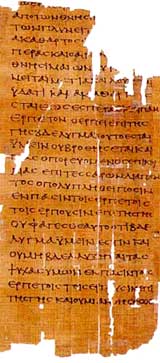 have known Hebrew (picture above: Torah Scroll).
have known Hebrew (picture above: Torah Scroll).
... when Jesus is described by the New Testament as quoting from the Hebrew Bible, the quotations that are given most closely correlate with the Septuagint, and not direct Greek translations of the Masoretic Text. This suggests that the New Testament authors most likely used an edition of the Septuagint, rather than a Hebrew or Aramaic source. Consequently, most scholars believe that when the New Testament authors were composing their works, they copied from the Septuagint (an existing, respected translation), rather than translate or paraphrase, themselves.
As an educated man and especially as a Rabbi, Jesus would have read the Septuagint, (right) the Bible used by all in those days (the Old Testament in Greek and the Bible used for 300 years by the Hebrews). As a Rabbi, and especially if Jesus were an Essene, he would have also read the Hebrew version of the Torah. The first five books of this comprise the Torah (or Pentateuch), the core sacred writings of the ancient Jews, traditionally written by Moses under divine inspiration. Dead Sea Scrolls, Hebrew, though differing from previous versions of Hebrew,
"was used from the 3rd century BCE to the 1st century CE, corresponding to the Hellenistic and Roman Periods before the destruction of the Temple in Jerusalem and represented by the Qumran Scrolls that form most (but not all) of the Dead Sea Scrolls. Commonly abbreviated as DSS Hebrew, also called Qumran Hebrew. The Imperial Aramaic script of the earlier scrolls in the 3rd century BCE evolved into the Hebrew square script of the later scrolls in the 1st century CE, still in use today."
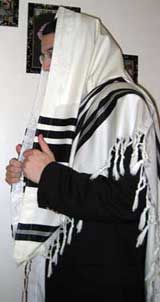 Jesus would have worn the Jewish clothing of the time and of his status (below: a modern prayer shawl) . He would have studied the Torah which we are told in the gospels, he quoted so very often. He would have been proficient in Greek, Hebrew, and Aramaic, and possibly would have known some Latin. The trade routes also ran through the region. Jesus would have been exposed to varieties of cultures and religions including Egyptian teachings, Buddhism, Zorastrianism and the Mystery religions of the Greco-Roman Empire. He would have known about the greater world and would have had knowledge of other Jewish communities which were spread throughout the Roman Empire, Egypt, and the Middle East.
Jesus would have worn the Jewish clothing of the time and of his status (below: a modern prayer shawl) . He would have studied the Torah which we are told in the gospels, he quoted so very often. He would have been proficient in Greek, Hebrew, and Aramaic, and possibly would have known some Latin. The trade routes also ran through the region. Jesus would have been exposed to varieties of cultures and religions including Egyptian teachings, Buddhism, Zorastrianism and the Mystery religions of the Greco-Roman Empire. He would have known about the greater world and would have had knowledge of other Jewish communities which were spread throughout the Roman Empire, Egypt, and the Middle East.
Galilee, the area that Jesus lived in, was a known and reputed hot spot for rebels and rebellions against the powers in charge of the government and the Temple, neither of which were seen to be as holding any "legal" authority to the Jews, rather, those in power held their positions because they were in league the Romans. There had not been legal powers with proper lines, in charge of Israel for hundreds of years. In fact, the Essenes formed as a separate sect 200 years earlier, apparently in reaction to the installation of the earlier Hasmonean priests in the Temple (another story addressed in the book). Rather the priests, installed by Herod the Great and Herod himself, and the family of Herod, were of mixed blood.
The lack of proper ancestry was not accepted by the greater population in Galilee, Palestine or in the Greater Diaspora. The Essenes were very vehement in their writings concerning their objections to the illegals in power. According to Josephus the Essenes had settled "not in one city" but "in large numbers in every town" (War 2.124). Philo speaks of "more than four thousand" Essaioi living in "Palestinian Syria" (Quod Omn. Prob. XII.75), more precisely, "in many cities of Judaea and in many villages and grouped in great societies of many members" (Hyp. 11.1)." Our author hints at the possibility that Nazareth was an Essene community or a sect with close affiliations to the Essenes; perhaps an off shoot. The main camp of the Essenes. was very near to the 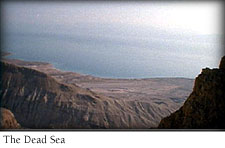 locations in which John the Baptist and Jesus first began their ministries.
locations in which John the Baptist and Jesus first began their ministries.
"As you leave Jerusalem and go to the south and to the east, toward the Dead Sea, the terrain changes rapidly and starkly. You move off gradually from [the] ... rolling hillside, through the ravines, and it becomes stark and desolate. It's dry. It's arid. It's rocky, and it's rough. And all of a sudden, within a span of only about thirteen miles, the entire terrain drops out in front of you as you go from roughly 3400 feet above sea level at Jerusalem, to nearly 1400 feet below sea level at the surface of the Dead Sea. It is in that rugged cliff face, on the banks of the Dead Sea, in this arid, desolate climate, that the Dead Sea Scrolls were discovered at the site known as Khirbet Qumran."
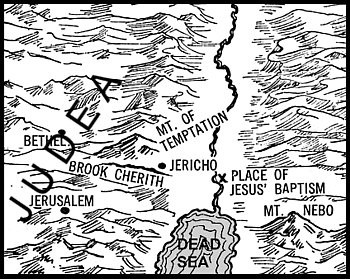 The Essene's mission was to install the rightful heirs to the throne and to the temple, in the form of not one, but two Messiahs, one: a real King, two: a real High Priest, both with true ancestral lines. In other words, the author asserts, Jesus and John the Baptist were actually seen as the two Messiahs and also believed themselves to be those figures. The author makes the case, that later Christians, most especially Paul, who was an educated Greek, and unaware of the particulars and importance of John the Baptist, simply left him out of the picture. He asserts that probably due to due to his Greek education, his Hellenized Judaic perceptions of the world and his spectacular mystical visions, that he elevated Jesus to Godhood and following the traditions of the Greek Mystery schools created the ritual of communion. The author asserts that the original mission and message of Jesus was corrupted by Paul.
The Essene's mission was to install the rightful heirs to the throne and to the temple, in the form of not one, but two Messiahs, one: a real King, two: a real High Priest, both with true ancestral lines. In other words, the author asserts, Jesus and John the Baptist were actually seen as the two Messiahs and also believed themselves to be those figures. The author makes the case, that later Christians, most especially Paul, who was an educated Greek, and unaware of the particulars and importance of John the Baptist, simply left him out of the picture. He asserts that probably due to due to his Greek education, his Hellenized Judaic perceptions of the world and his spectacular mystical visions, that he elevated Jesus to Godhood and following the traditions of the Greek Mystery schools created the ritual of communion. The author asserts that the original mission and message of Jesus was corrupted by Paul.
 Now we have heard some of these things before, but what makes this book unique is that the author backs up all of his assertions using, archeology, known history, historical passages from Josephus and Philo and a few others, and he corresponds his views with Biblical passages of the Old and New Testament and he corrects some mistranslations of words and thus passages. He also uses passages from the Dead Sea Scrolls and quotes the Didache. In doing so, he creates a picture of Jesus and John the Baptist as inheritors of true traditional Royal and Sacred lineages. Most of all, he puts himself into the circumstances of Jesus. In the light the author creates, we intellectually and emotionally follow Jesus throughout his ministry as he reacts and responds to particular events. In that light, in the light of historical particulars, we begin to understand how Jesus as a Jew and as of Royal lineage may have felt and many of his words and actions become more understandable.
Now we have heard some of these things before, but what makes this book unique is that the author backs up all of his assertions using, archeology, known history, historical passages from Josephus and Philo and a few others, and he corresponds his views with Biblical passages of the Old and New Testament and he corrects some mistranslations of words and thus passages. He also uses passages from the Dead Sea Scrolls and quotes the Didache. In doing so, he creates a picture of Jesus and John the Baptist as inheritors of true traditional Royal and Sacred lineages. Most of all, he puts himself into the circumstances of Jesus. In the light the author creates, we intellectually and emotionally follow Jesus throughout his ministry as he reacts and responds to particular events. In that light, in the light of historical particulars, we begin to understand how Jesus as a Jew and as of Royal lineage may have felt and many of his words and actions become more understandable.
We also get a more accurate view of the reaction of the populations to Jesus and why they responded to him in such great numbers. We are able to see how the people would have perceived John the Baptist and Jesus. We understand how Jesus may have felt when John the Baptist was murdered and more about his views concerning the poor and the powers that were in charge. The gospels make more sense as we get a glimpse of a truer political picture of the times. We are able to understand the mission of Jesus in a whole new light and we gain a respect for John the Baptist as his partner; we gain a larger picture than has been before available.
As for Mary, her life becomes more real and down to earth. We see her as the matriarch of a Davidic family having royal blood. In James, we find a valid successor and we also come to understand that he was killed for the same reason that Jesus was killed --- to wipe out the dynastic line. As for the Herodians, we are able to ascertain they had good reason to find a way to get rid of Jesus, John the Baptist, and James (left), for in the population's eyes, Jesus IS a real claimant for king, John the Baptist, is a real claimant to the High Priesthood, and James is a real Royal successor.
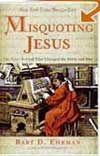 Bart D. Ehrman, who has authored or edited 19 books, that have changed our lives, including The New York Times Best-seller, Misquoting Jesus, writes about James Tabor's new book, The Jesus Dynasty:
Bart D. Ehrman, who has authored or edited 19 books, that have changed our lives, including The New York Times Best-seller, Misquoting Jesus, writes about James Tabor's new book, The Jesus Dynasty:
"Many scholars have undertaken studies of Jesus and his legacy; none has dared advance the boldly provocative theses of The Jesus Dynasty. For sheer breadth of vision and imaginative reconstruction, rooted deeply in the historical sciences, this promises to be a book unlike any the public has ever seen."
According to one survey, 63% of Americans think the Bible is literally true. Currently, mainstream Christianity and developing New Christianities, especially those that are springing up in the whole of the Southern Hemisphere, in too many cases, are taught the teachings of Jesus Christ; according to the same old dogmatic ideas;the Bible is literally true and if you don't believe that Jesus was the one and only Son of God, one is destined for hell. I am certain, if widely read (and I hope it will be), that this book will effect another more accurate revision of the entire life of Jesus. In the meantime, it gives us a lot to think about. The book is well written, especially in light of known historical evidence. Tabor makes it very easy to step into the shoes of Jesus and walk with him in Ancient Israel.
Good Reading, Jessika
 The Jesus Dynasty:The Hidden History of Jesus, His Royal Family, and the Birth of Christianity (Hardcover) by James D. Tabor.
The Jesus Dynasty:The Hidden History of Jesus, His Royal Family, and the Birth of Christianity (Hardcover) by James D. Tabor.
If I wanted you to read any book this year and I only had one to choose, it would be this one! Jessika
